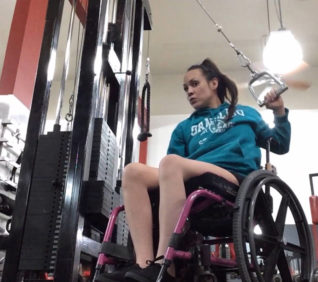Everyone know that exercise is good for them. But, a physically disabled exercise routine, is perhaps, even more important.
In general, regular exercise just makes you feel better and have more energy. Yet, according to the Centers for Disease Control and Prevention (The CDC), “Nearly half of adults with disabilities who are able to be physically active don’t get any aerobic physical activity.” There are a number of barriers to a physically disabled exercise routine, but these can be overcome. It’s important to just get started and find what’s right for you.
A physical disability does not equal poor health, and most adults with disabilities are able to participate in regular physical activity and avoid being inactive. There are lots of options for a physically disabled exercise routine — from dog walking to wheelchair rugby. It’s important to find activities that are a fit with your interests and abilities as well as to find ways to participate at the level that’s right for you – highly competitive, social competitive or recreational.
Getting Started with Exercise for the Physically Disabled
The Mayo Clinic recommends at least 150 minutes a week of moderate-intensity exercise OR 75 minutes a week of vigorous exercise. If you have not been exercising regularly, this could be a lot. Set goals and build up to a place that is right for you. The key is to start then establish a routine, so you stick with it.
Nearly any activity that you can think of can be adapted to accommodate varying abilities, including strength training, stretching exercises and cardio conditioning as well as a wide variety adaptive sports.
Discover-Accessible-Fitness (PDF)
A wheelchair user’s guide for using fitness equipment
Exercising in a Chair or Wheelchair
A few tips for in chair or wheelchair exercising:
- Choose a chair that allows you to keep your knees at 90 degrees when seated
- Securely apply the brakes or otherwise immobilize the chair
- Sit up tall and straight while exercising
- Use your abs to maintain good posture
Overcoming Barriers
Despite the best of intentions, getting started is not easy. Many people face emotional barriers in addition to their physical challenges. It’s common for people to feel self-conscious about their disability, illness, injury or weight. The good news is that there are lots of ways and places to be active – at your home, outside at a gym and solo, as a group or as part of a team.
Three things to remember when starting an exercise routine:
- Focus on your abilities and what adaptions can be made to get you doing what you want to do
- Be proud of effort you make to exercise
- Have fun – exercise WILL make you feel good, but should be enjoyable too
Be Safe
Check with your doctor, if you’re not sure if a particular activity is safe for you or should be modified in any way to accommodate you.
And, always be sure that you have the right safety and protective gear when it’s recommended (e.g., helmets for handcycling, personal flotation device for paddle sports).


Leave a Reply